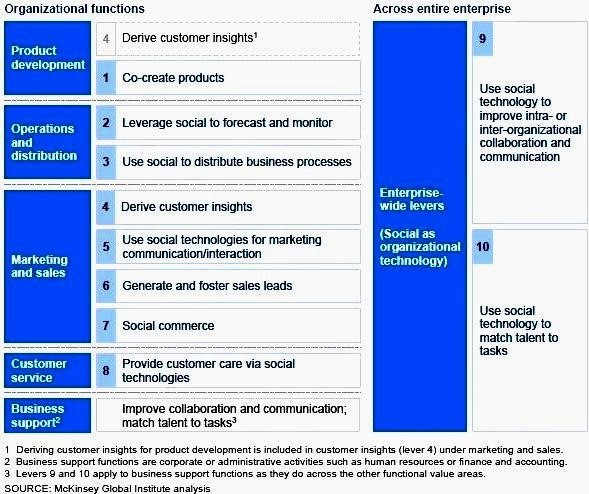 Jeff Bullas, who has been named by Forbes one of the world's top social marketing talents, has published a helpful article for all those who want to find out how social technologies add value to their daily life.
Jeff Bullas, who has been named by Forbes one of the world's top social marketing talents, has published a helpful article for all those who want to find out how social technologies add value to their daily life.
Pointing out that across every industry lies an enormous potential to add more value through implementing social technologies - from better customer insights, improved marketing to social commerce - he lists the following ten ways social technologies can add value in organizational functions within and across enterprises:
1. Co-create products: Companies using social platforms can crowd source ideas from their consumer community. This could include product ideas, evaluation of the ideas by the crowd and the continuing modification and evolution of the products and services to produce a better product that better meets their needs. It could include consumers submitting designs.
2. Demand forecasting: Through multiplying the potential sources of information about demand, companies can obtain more accurate and granular data. This could lead to better inventory control and better placement of stock where local demand is higher. The buzz from social networks can help pinpoint where the first responders are and allow staff to redirect additional stock to the highest buzz spots.
3. Distributing business processes: Companies such as TomTom and Google Maps are using in/out from users to locate and qualify mapping errors and the latest updates to road networks. TomTom is even now adding crowdsourced real time traffic flow to its service that provides the latest data on traffic jams and accidents provided by users from their cars.
4. Market research: Market research can be costly and take months but now you can gather online chatter about your competitors in real time. There are now tools that can measure sentiment as it happens that allows companies to see if the latest feedback about a product is positive or negative. Brand health can now be checked by the “Chatter” tone online.
5. Marketing communications: Marketing interaction was limited in the past to snail mail and was costly and slow. Now we have communication that is effectively close to zero cost and provides feedback in minutes. You can see which types of marketing communications are engaging and which aren’t. Online customer communities are being created by the savvy enterprise with Adobe’s forums having one million members.
6. Lead generation: Sales opportunities required telemarketing and expensive advertising to make the phone ring. B2B companies are now discovering the power of social networks to attract customers and drive inbound inquiries. Displaying a company’s expertise via blogs and online whitepapers and eBooks are transforming how professional services companies market their business. Software companies such as HubSpot have created online tools that allow companies to become much more efficient with their marketing.
7. Social commerce: All of us listen to the recommendations of friends and family and social commerce allows companies to make it easy for their consumers to share what they have bought or “like”. This amplifies the marketing message and improves conversion for online stores.
8. Customer care: Companies such as South West Airlines use channels like Twitter to respond to potential PR issues that are quickly diffused before they turn into public relations disasters. Agencies and larger brands are monitoring social media channels with community managers who monitor social networks such as Facebook to turn customer care problems into opportunities to impress customers with the speed of the response.
9. Collaboration: Social technologies are improving organizational performance by making collaboration and co-creation efficient both internally and with external suppliers and partners. This reduces time spent with face to face meetings and ensuring that best practice is followed and shared. Companies such as 37Signals uses social technologies to run a multimillion-dollar company that operates with only 16 employees and is spread across 6 countries.
10. Matching talents to Roles: Social platforms such as LinkedIn provide insights into people’s skills, passions and interests that provide a more complete picture of a candidate than a one-dimensional resume will ever achieve.
Source: Jeff Bullas



















